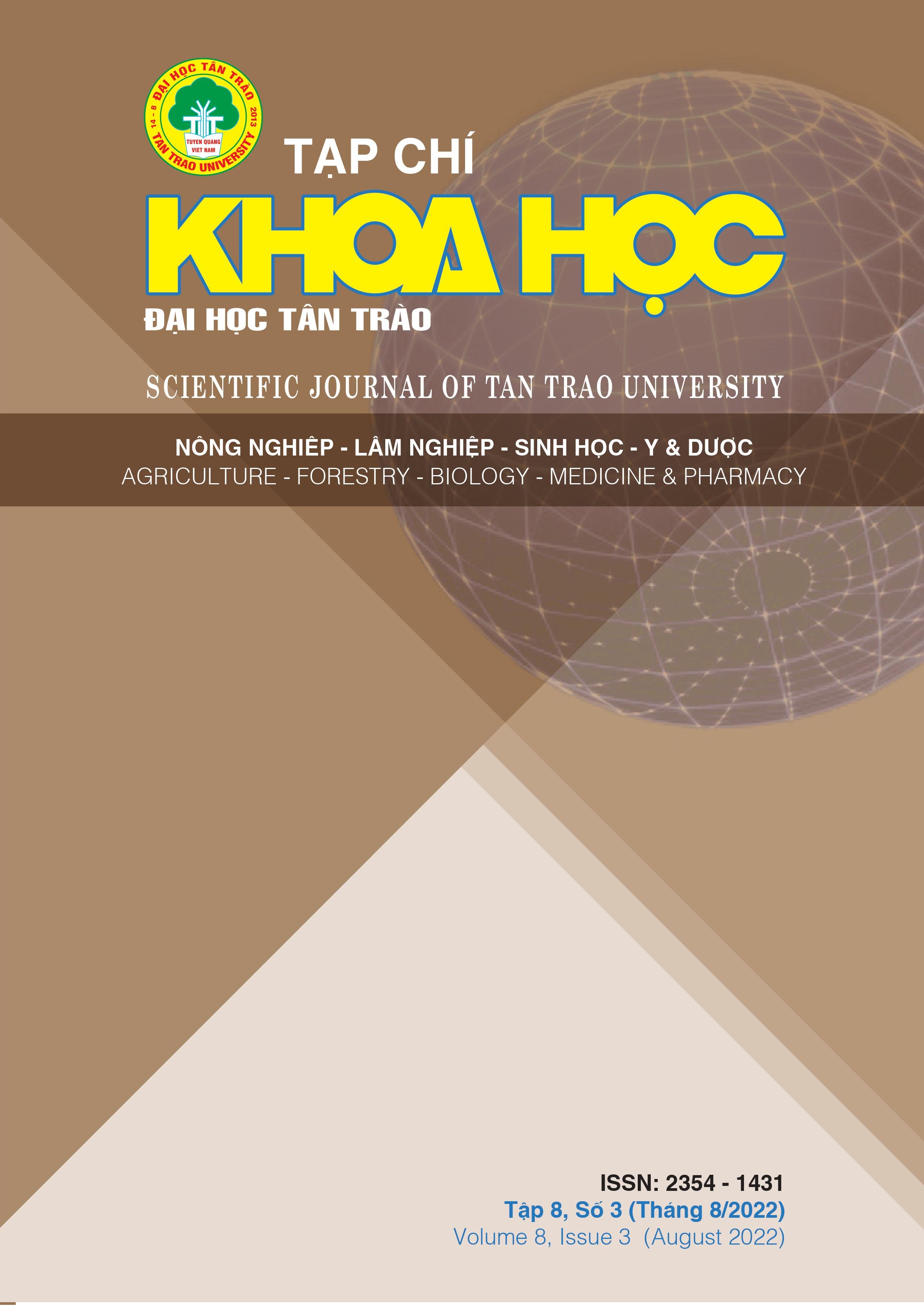RESEARCH ON CHEMICAL COMPOSITION AND ANTIOXIDANT ACTIVITY OF CINNAMOMUM BURMANNII ESSENTIAL OIL IN BAO LAC, CAO BANG PROVINCE
DOI:
https://doi.org/10.51453/2354-1431/2022/805Keywords:
GCMS, Cao Bang, DPPH, Cinnamomum burmanii Essential oilAbstract
The objective of the study was to investigate the chemical composition and biological activity of Cinnamomum burmannii essential oil in Cao Bang province. Use the steam distillation method to extract essential oils. The chemical composition of essential oils was determined by Gas chromatography-mass spectrometry (GCMS). Evaluation of the antioxidant capacity of Cinnamomum burmannii essential oil by using DPPH free radical method. The results of this study have determined that Cinnamomum burmannii essential oil has 23 components with the main components including Citronellal (52.82%), Citronellol (25.13%), 1, 8-Cineole (5.04%). Cinnamomum burmannii essential oil has the antioxidant capacity with IC50 value = 12.03 μg/ml. These results created a base for further research, and development of functional products, care healthy products from the chemical components of this plant.
Downloads
References
[1]. Al-Dhubiab, B. E, "Pharmaceutical applications and phytochemical profile of Cinnamomum burmannii," Pharmacognosy reviews, 6(12), pp.125-131, 2012.
[2]. Chandurkar, P., Tripathi, N., Choudhary, A., & Murab, T, "Antibacterial properties of cinnamon stick oil with special reference to Streptococcus pyogenes and Pseudomonas aeruginosa," Int. J. Curr. Microbiol. App. Sci, 3(2), pp. 177-178, 2014.
[3]. Kuspradini, Harlinda, et al, "Bioactivity of essential oils from leaves of Dryobalanops lanceolata, Cinnamomum burmannii, Cananga odorata, and Scorodocarpus borneensis," Agriculture and Agricultural Science Procedia 9: pp. 411-418, 2016.
[4]. Shan, B., Cai, Y. Z., Brooks, J. D., & Corke, H, "Antibacterial properties and major bioactive components of cinnamon stick (Cinnamomum burmannii): activity against foodborne pathogenic bacteria," Journal of agricultural and food chemistry, 55(14), pp. 5484-5490, 2007.
[5]. Su J, Chen L, Li B, Li L, "Extraction and composition analysis of volatile components in leaves of Cinnamomum burmannii B1," Shipin Kexue.;31:399–401, 2010.
[6]. Deng CC, Huo LN, Li PY, et al, "Chemical constituents and antioxidant activity of essential oils from leaves of Cinnamomum burmannii in Guangxi," Zhongguo Shiyan Fangjixue Zazhi; 16:105–9, 2010.
[7]. Nguyễn Thị Thu Thảo, Phùng Thị Lan Hương, Hoàng Thị Lý. "Nghiên cứu thành phần hóa học và ứng dụng sản xuất dầu cao xoa của tinh dầu quế trồng tại tỉnh Phú Thọ". Study Aids & Test Prep Documents, (2021).
[8]. Ying Liang, Yi Li, Aidong Sun, Xianjin Liu, "Chemical compound identification and antibacterial activity evaluation of cinnamon extracts obtained by subcritical n-butane and ethanol extraction, " Food Sci Nutr;7: pp. 2186-2193, 2019.
[9]. Zhang J, Wen S, Fulin L, Huang S, Diao S, Zhu Y, et al, "Effects of temperature, light and pH on DPPH radical scavenging activity of anthocyanin extracted from fruit of Cinnamomum burmannii," J Food Sci.; 30:120-3, 2009.
[10]. Kuspradini, Harlinda, et al, "Bioactivity of essential oils from leaves of Dryobalanops lanceolata, Cinnamomum burmannii, Cananga odorata, and Scorodocarpus borneensis," Agriculture and Agricultural Science Procedia 9, pp. 411-418, 2016.
Downloads
Published
How to Cite
Issue
Section
License

This work is licensed under a Creative Commons Attribution-ShareAlike 4.0 International License.
All articles published in SJTTU are licensed under a Creative Commons Attribution-ShareAlike 4.0 International (CC BY-SA) license. This means anyone is free to copy, transform, or redistribute articles for any lawful purpose in any medium, provided they give appropriate attribution to the original author(s) and SJTTU, link to the license, indicate if changes were made, and redistribute any derivative work under the same license.
Copyright on articles is retained by the respective author(s), without restrictions. A non-exclusive license is granted to SJTTU to publish the article and identify itself as its original publisher, along with the commercial right to include the article in a hardcopy issue for sale to libraries and individuals.
Although the conditions of the CC BY-SA license don't apply to authors (as the copyright holder of your article, you have no restrictions on your rights), by submitting to SJTTU, authors recognize the rights of readers, and must grant any third party the right to use their article to the extent provided by the license.


